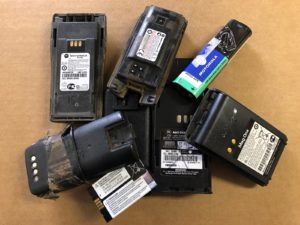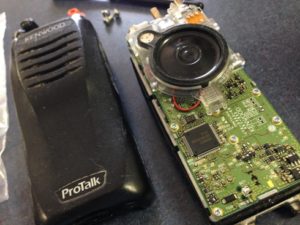wet 2-way radio?
 Don’t wait until your radio is corroded and rusty inside to send it in for repair.
Don’t wait until your radio is corroded and rusty inside to send it in for repair.
By then it may be too late to repair your wet radio. Once a radio has become wet, corrosion starts to form rather quickly and deteriorate the metal. Good news, many times it is possible if caught early to restore a radio which has become wet. Early signs of corrosion can be removed and stopped.
Some basic information on what to do if your radio encounters water:
- Remove the battery. Do not turn on or try to use the wet radio, as this could cause further damage. (If you feel the battery has became wet inside, you will need to replace it.)
- Thoroughly dry the radio. You can use a towel on the exterior and any internal battery compartment. If you feel the water has intruded further, use a blow dryer on a low setting to air dry the radio. Specialty EVAP-bags can help to remove the moisture (700x more effective than rice). Call our office, 800-872-2627, and inquire about availability of EVAP-bags.
- Get the radio to a radio repair facility ASAP. The longer you wait, the more likely the radio will grow corrosion, and be deemed non-repairable.
Watch for IP57 or IP67 ratings when purchasing radios for the most water resistance. IP stands for Ingress Protection.
We’re here to help, and do our best to bring your radio back to good working condition. Give us a call here at Delmmar Communications if you have questions or need more info, 800-872-2627.

 It happens more often than you might think… an employee comes in to tell the boss “someone ran over my radio”. It is not something a business owner or manager wants to hear. The
It happens more often than you might think… an employee comes in to tell the boss “someone ran over my radio”. It is not something a business owner or manager wants to hear. The 







 So you are probably used to seeing your local law enforcement officers wear a remote speaker mic on their shoulder. It’s identifiable, something that seems to be part of their uniform. But did you know many other industries use these devices too? Just to name a few: manufacturing, amusement, sporting and entertainment venues all take advantage of the convenience of the
So you are probably used to seeing your local law enforcement officers wear a remote speaker mic on their shoulder. It’s identifiable, something that seems to be part of their uniform. But did you know many other industries use these devices too? Just to name a few: manufacturing, amusement, sporting and entertainment venues all take advantage of the convenience of the